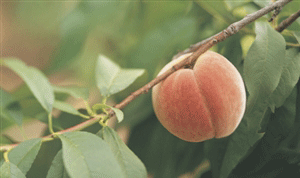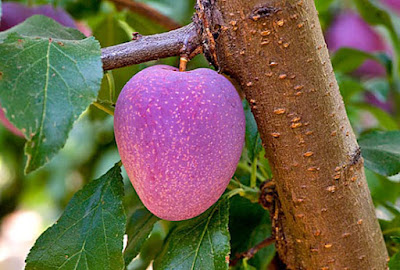Just when you thought you had reached the heart of fruitopia passing by the tasty strawberries and cherries, the refreshing oasis of apricots and peaches you fly over a bump in the road and the whole landscape changes.
What happened to all that sun-coddled, high-summer fruit? It’s been stockpiled away in a frenzy of freezing and jam-making, pies and tarts. In its wake, there’s a brand new world of blackberries, apples and figs announcing summer’s last stand and the first, tantalizing whiff of fall.
If you’re Summer Sebastiani, pastry chef at All Seasons Bistro & Catering in Calistoga, you’re just getting warmed up to the sweet kitchen, with its tantalizing array of fruit desserts, jams and syrups.
“We do a lot of brandied cherries and preserved lemons,” she said at the Calistoga bistro, opened in 1984 by Gayle Keller and Alex Dierkhising. “I made plum jam from the farmers market. We get them at their peak, and it’s really easy.
This month, Sebastiani is showcasing the late-summer fruits that she gleans from back yards, farmers markets and the coastal ranch where she grew up.
“Backyard fruit is the best,” she said. “I usually bring in Gravensteins, Pippins and pears from my dad’s ranch in Annapolis. He has a 250-year-old orchard.”
The 34-year-old chef, who grew up in an Italian family with a 1-acre garden and a freezer full of fresh beef and wild game, graduated from the California Culinary Academy in San Francisco in 2000. She did her externship at Guerneville’s elegant Applewood Innwith chef David Frakes, now at Beringer Vineyards.
Sebastiani served as the opening chef for the Quail Inn at Oakmont, then spent four years at Brannan’s Grill in Calistoga before moving over to the All Seasons Bistro in 2003.
“I started as a pastry chef,” she said. “That’s where my heart is.”
Over the years, however, the capable cook took over as the catering chef and then the restaurant chef at All Seasons, designing the bistro’s seasonal Wine Country menu with Keller. She also oversees the bistro’s sister restaurant, Hydro Grill, across the street.
“Why not cook with the best ingredients at their peak ripeness?” Sebastiani asked. “We cure our own olives and make our own ricotta, goat cheese and creme fraiche.”
On the dessert menu, Sebastiani makes everything from scratch, creating layers of flavor and texture whose whole is greater than its parts. She even makes her own vanilla extract and a line of syrups from vodka and fresh fruit, which she uses to flavor cakes.
With the explosion of blackberries reaching peak ripeness this month, Sebastiani likes to simmer a berry compote that she serves with a crystallized ginger cake topped with whipped cream infused with lime and garnished with mint.
“It’s a really delicious cake,” she said. “It’s made with sour cream so it stays moist.”
With the new crop of fall figs starting to drop into the market, she creates an elegant Fig Napoleon with phyllo dough that’s layered with maple syrup and topped with goat cheese ice cream.
“I make a fig jam, and then I toss the whole figs in it,” she said. “For the jam, you use half as much sugar as figs, add the acid, then puree it.”
Meanwhile, the tart Gravenstein apples make a delicious foil for the rich pastry of a frangipane filling, which Sebastiani whips up from eggs, sugar, almond paste and butter.
For dough and all things pastry-related, Sebastiani relies on her baking mentor, renowned pastry chef Sherry Yard of Spago Beverly Hills, who explains the chemistry of baking in her cookbook, “The Secrets of Baking.”
“She takes basic recipes and shows you how the different methods turn it into something else,” Sebastiani said. “She explains the simple steps, and she’s easy to follow.”
In Sebastiani’s copy of the cookbook, Yard wrote an inscription: “To Summer, a kindred baker: Wishing you a lifetime of rolling in dough!”
Sebastiani hasn’t always been rolling around in dough, but almost. She was born and raised in Annapolis, a distant relative of the famed Sebastiani wine family. She went to Point Arena High School and got her first job at age 12 working in the kitchen of a local YMCA camp as a dishwasher and prep cook.
While still in high school, she took a job at a bakery in Gualala, showing up at 4 a.m. to help the baker with muffins and bread, then working the cash register.
While pursuing photography — still one of her favorite hobbies — at Santa Rosa Junior College, Sebastiani decided that cooking was her destiny.
“My mom asked, why aren’t you cooking?” she said. “My great grandmother’s sister owned Bertolucci’s restaurant in South San Francisco.”
This past winter, Sebastiani won the Critic’s Choice Chef of the Year at the 2009 Napa Valley Mustard Festival for a simple soup of asparagus and mustard greens with housemade cheddar mustard seed crackers.
“Really, we just tried to figure out what would be in season,” she said of the honor. “I made the soup on my way out the door, and I got there just minutes before the judging.”
Much to her delight, the soup won against many of the top restaurant chefs in Napa, hailing from such iconic kitchens as Meadowood, La Toque and the Silverado Resort.
“It was only the second soup that had ever won,” she said proudly. “A good 85 percent of the chefs did pork, but that’s hard to digest.”
Growing up in a northern Italian family, Sebastiani said, means she has always eaten lots of fresh vegetables, and plenty of seasonal fruit.
In her spare time, Sebastiani enjoys photography, sewing, scrapbooking, caring for her four pugs and landscaping her home in Santa Rosa’s Coffey Park neighborhood, where she lives with her husband, Todd Fernandez.
Although she has lived in Santa Rosa for 12 years, the pastry chef feels even more at home in Calistoga, where she knows practically everyone.
“It’s a small town, but it’s so close to everything else,” she said. “And the people are pretty cool.”
The following recipes are from Summer Sebastiani of All Seasons Cafe. You can substitute any fruit for the blackberries in the compote. Sebastiani serves this cake with a wildflower honey and ginger ice cream or some whipped creme fraiche.
Crystallized Ginger Cake
with Blackberry Compote
Makes 1 cake
For cake:
—Softened butter (for brushing pan)
½cup raw sugar (large grain, to give a sparkle)
2¼cups all-purpose flour
4teaspoons ground ginger
2teaspoons baking powder
½teaspoon salt
1cup (2 sticks) unsalted butter, room temperature
2cups sugar
2large eggs
1large egg yolk
2teaspoons sour cream
1cup chopped crystallized ginger
For berry compote:
¼cup water
1/3cup sugar
1tablespoon fresh lemon juice
½pound blackberries (about 2 cups)
For cake: Preheat oven to 350 degrees.
Brush softened butter generously all over inside of a 12-cup Bundt pan. Sprinkle raw sugar over butter in pan, tilting pan to coat completely.
Whisk flour, ground ginger, baking powder and salt in medium bowl. Using electric mixer, beat 1 cup butter in large bowl until smooth.
Add 2 cups sugar; beat on medium-high speed until blended, about 2 minutes. Add eggs one at a time, beating well after each addition.
Beat in the one egg yolk and vanilla, stopping to scrape down bowl as needed.
Add flour mixture in 3 additions alternatively with sour cream in two additions, beating on low speed just until blended after each addition.
Mix in crystallized ginger. Spread batter in pan, being careful not to disloge raw sugar.
Bake cake until top is light brown and tester inserted near center comes out with just a few small crumbs attached, about 55 minutes. Transfer to rack; cool in pan 15 minutes. Gently tap bottom edge of pan on work surface while rotating pan until cake loosens. Place rack atop pan and invert cake onto rack; remove pan. Cool completely.
For compote: Place the water, sugar, lemon juice and half of the blackberries in a heavy bottom sauce pan and bring up to a boil then turn off the heat and add the remaining blackberries.
To serve: Cut cake into wedges and serve with the blackberries on top and a dollop of whipped creme fraiche.
Sebastiani serves this tart with cinnamon ice cream or caramel whipped cream.
Apple Frangipane Tart
For dough:
2¼cups all-purpose flour
1teaspoon salt
¾cup butter
¼cup water
For frangipane:
¼cup butter
1/3cup white sugar
1½cups almond paste
4whole eggs
¾cup cake flour
For apple marmalade:
1teaspoon pectin
1cup sugar
1tablespoon lemon juice
1tablespoon apple jack (whiskey)
½vanilla bean, scraped
1cinnamon stick
—Dash of ground nutmeg
1star anise
1quart Gravenstein apples, peeled and small dice
For dough: Preheat oven to 350 degrees.
Take the butter and cut it into small pieces, then put it in the fridge to stay cold while you measure the other ingredients.
Using an electric stand mixer with a dough hook, start your flour and salt on low speed. Immediately add all of the butter and ice water. Mix just until the dough becomes one mass (you should still see lumps of butter, so it makes a crispy crust. ). Alternately, pull the dough out of the mixer before it fully comes together and finish kneading by hand to insure that you don’t overmix.
Cover and place the dough in the refrigerator for 4 to 12 hours. Pull the chilled dough from the refrigerator and roll. It will be hard at first to roll the dough, so keep rotating the dough as you roll it out until it softens up. Roll the dough into a ¼-inch thick piece, then cut to desired shapes. Place in individual tart shells and chill.
Place parchment paper on a sheet pan. Weigh down the inside of the tart shells with beans or a ramekin and bake for about 10 minutes until edges are golden brown.
For frangipane:
Beat butter, sugar and almond paste in a bowl with an electric mixer at medium speed for three minutes.
Add eggs, one at a time, beating well after each addition, then beat in flour.
Spread frangipane filling in cooled shell.
For apple marmalade:
Mix pectin and half of the sugar and reserve for later. This will help thicken the juice from this mixture.
Mix the rest of the sugar, lemon juice, apple jack, vanilla bean and spices and put in a sauce pan. Bring to a boil and let boil for two minutes. Add diced apples and wait for the liquid to come bakc to a boil.
Stir in pectin mixture and bring back to a boil and cook about another 2 minutes, until apples start to become tender. Pull from heat and transfer to a bowl and let chill in the refrigerator. Pull out the whole spices.
To assemble: Drain fruit in a sieve set over a bowl, reserving syrup, and scatter fruit over filling, pressing in slightly. Bake tarts on cookie sheets lined with parchment paper until puffed and golden, 30 to 40 minutes. Transfer tarts on the parchment paper to a rack. Brush reserved syrup over tart and cool to warm or room temperature.


























